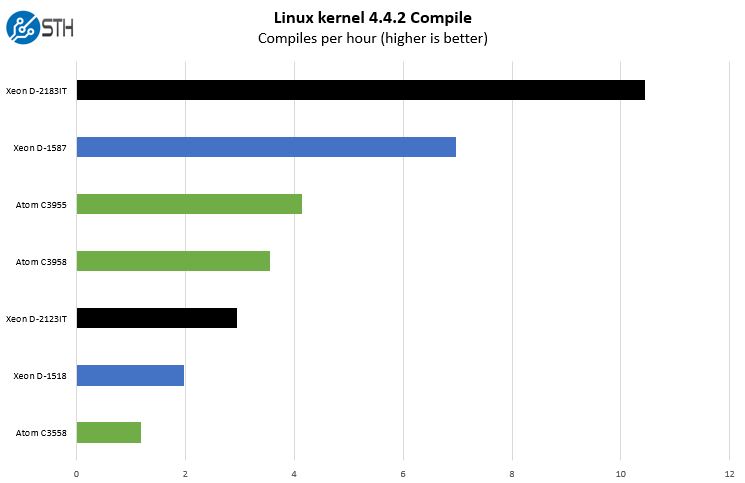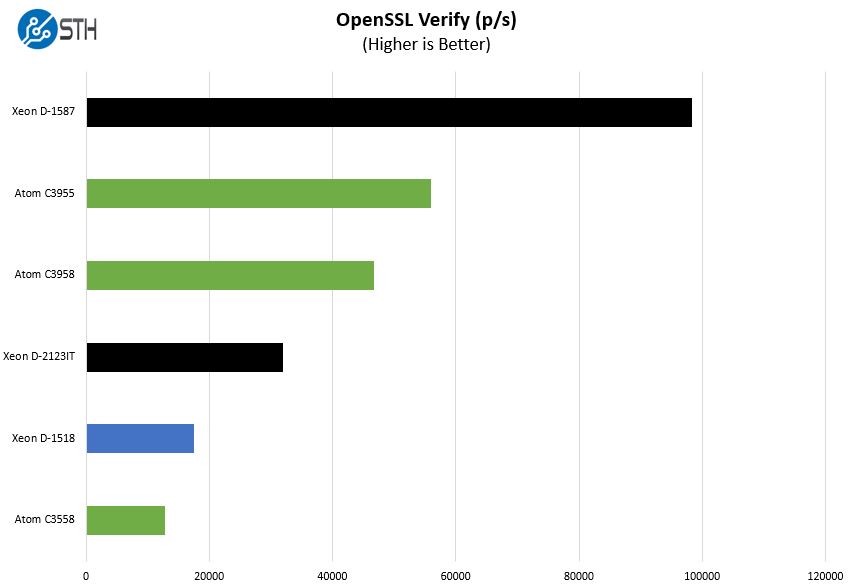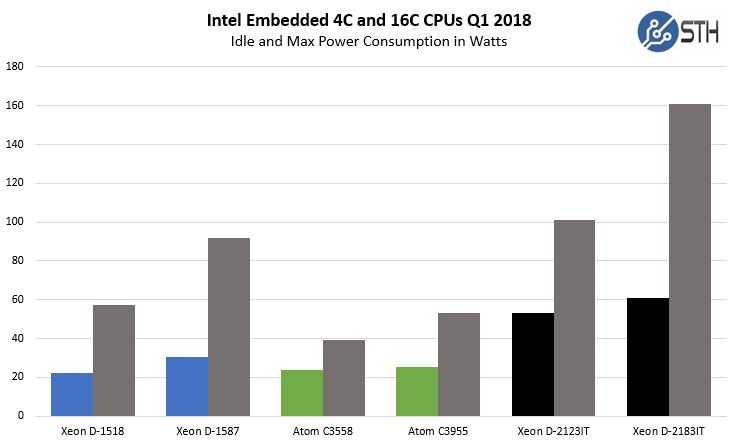Supermicro X11SDV-16C-TP8F Performance
We wanted to provide a few data points to show just how much faster the new 16 core / 32 thread Intel Xeon D-2183IT solution is versus the previous generation Xeon D-1587 16 core / 32 thread model. We also have the Atom C3000 series and 4 core models represented to show what the ranges are for the different series. This shows some of the lower power offerings such as the Supermicro X11SDV-4C-TLN2F with Intel Xeon D-2123IT and Supermicro A2SDi-16C-HLN4F with Intel Atom C3955 that are also focused in the embedded space.
One benchmark we typically use for this is our Linux kernel compile benchmark. This touches a decent amount of the total system performance factors and is something many Linux admins and developers have the first-hand experience with.

Here is the intriguing part of this chart. You could consolidate four Intel Xeon D-1518 platforms into a single Intel Xeon D-2183IT platform here. Likewise, you get about 50% more performance with this iteration of the 16 core Xeon D. Where an Intel Xeon D-1587 was around a single Intel Xeon Silver 4114 in this benchmark, an Intel Xeon D-2183IT is akin to an Intel Xeon Gold 6132, a current generation mainstream $2100 CPU. The new generation has more cache, higher clocks, more memory bandwidth and higher thermal envelopes to it is able to push performance higher than the D-1500 series.
Here is a good example of non-QAT accelerated OpenSSL Verify tests on the same set of CPUs:

Here we see a bit over a 50% improvement which is significant.
These are just two performance data points, but they highlight the general trend we are seeing. The X11SDV core-for-core is significantly faster than the X10SDV generation parts.
While it is a more robust platform, more performance can mean more power consumption which we recorded during our testing.
Supermicro X11SDV-16C-TP8F Power Consumption
In terms of power consumption, we wanted to give a view that shows the idle and maximum observed power consumption of the Supermicro X11SDV-16C-TP8F compared to other embedded solutions at 4 core and 16 core levels.

Although you get a lot of performance, you are paying for that in terms of power consumption. The new platform uses significantly more power than previous generations. For some applications, you may still use the Xeon D-1500 parts based on power envelopes. On the other hand, if you are more space constrained, the Supermicro X11SDV-16C-TP8F is just about as much performance as you can fit into a short depth rackmount enclosure.
Final Words
Intel priced the Intel Xeon D-2183IT at the same level as the Xeon D-1587, around the $1760 mark. That fact alone means that we expect this board to retail for over $2000 when it hits shelves. On the other hand, one is getting performance in the Intel Xeon Gold 6132 range in many applications from a small footprint embedded platform. There is a ton of networking with 4x 1GbE and 4x 10GbE ports, two of which are SFP+ ports. Storage is extremely flexible. With this generation, one can have several NVMe devices or a mix of NVMe and SATA devices which is handy. Although we do not see this as a threat to mainstream Xeon, the Supermicro X11SDV-16C-TP8F is an extremely versatile and powerful network and virtualization appliance for edge, on-prem, and customer-prem deployments.




The real question, as is always, is when can we get our hands on these beauties. Over the years I’ve lost track of the number of great SKUs we’ve seen reviewed here that never seem to hit the retail channel.
John S. – it should be soon from what we are hearing. The bigger constraint is that very little server gear (relatively) is sold through traditional retail. It is good to have a sales rep instead of simply looking on Amazon or Newegg.
Is there any reason why Super Micro didn’t do 8 DIMM / 2DIMM per Channel? It should be cheaper on Memory Cost.
I wish Intel could have allowed 1TB Memory Support, perfect for In-Memory caching server.
Ed – you would have to ask them. From the PCB, it looks like they would not have fit FlexATX if they added four more DIMM slots and the additional wires for more RAM slots.
@Patrick did you hear back from Supermicro about JSIM1 slot and WAN card support ?
That is what it is for. I believe I answered this in the forums as well.
@Patrick – in Super Micro’s Feb 27, 2018 press release, they state: “up to four 10GbE LAN ports with RDMA support”… Can you verify that RDMA is available on the X11SDV-16C-TP8F platform and is it iWarp or RoCE?
Thank you for the review!
One typo, though; it says 10GbE instead of 1GbE at the beginning of the second sentence:
“On the networking side, there is a lot. There are four 10GbE ports, two SFP+ cages (right) and to the left of those cages are two 10Gbase-T ports”
should be
“On the networking side, there is a lot. There are four 1GbE ports, two SFP+ cages (right) and to the left of those cages are two 10Gbase-T ports”